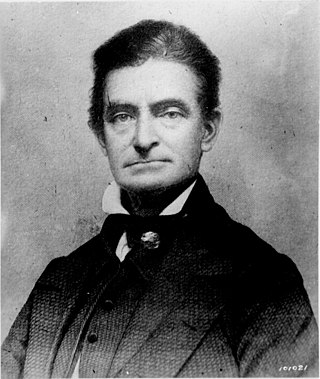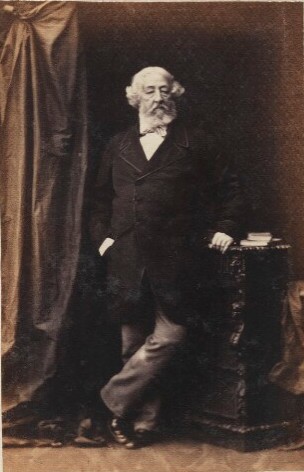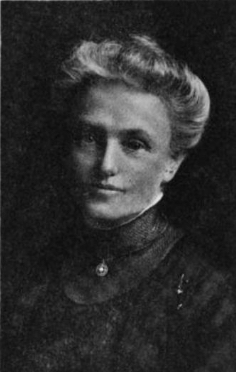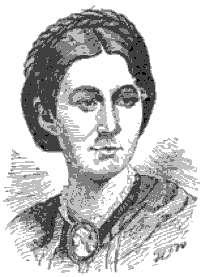Mary L. Day (born 1836, died after 1883) was an American writer, best known for her 1859 memoir Incidents in the Life of a Blind Girl and its 1878 sequel, The World as I Have Found It.
Mary L. Day (born 1836, died after 1883) was an American writer, best known for her 1859 memoir Incidents in the Life of a Blind Girl and its 1878 sequel, The World as I Have Found It.
Day was born in 1836, in Baltimore, and moved to Michigan with her parents as a small child. They lived in a log cabin until her mother died and her widowed father moved away, leaving the five Day children to the care of other families. [1]
When she was twelve, [2] Day lost her sight in a sudden attack of inflammation. Various interventions were attempted, including surgeries, but she remained blind. A foster family, the Cooks, read to her and taught her to knit. She moved to Chicago at 17, to live with a sister there, and then to Baltimore in search of more help. She enrolled at the Maryland Institution for the Blind in 1855. [1]
Day was one of a handful of blind authors familiar to American readers in mid-nineteenth-century. [3] She wrote two memoirs, Incidents in the Life of a Blind Girl (1859) and The World as I Have Found It (1878). She sold copies of Incidents to support herself, traveling the United States with a companion, [4] and making personal appearances. [5] [6] She also sold her knitting, her beading, and her handwoven baskets. She visited with President James Buchanan, who bought a book from her. She visited with Susan B. Anthony, but the encounter was "cruel", in Day's account, as Anthony scolded her and advocated restrictions on blind marriage and parenthood. [1] [3]
The World as I Have Found It carried an introduction by Charles Deems, a noted Methodist preacher. [7] Among the stories in the sequel were her impressions of the Solid Muldoon, a "petrified man" hoax in Colorado. [8] She also traveled to various American cities selling the second book. [9]
Before 1878, Mary L. Day married a businessman known as "Mr. Arms". [1] [7] She was living in Shasta County, California, in 1883. [10] Day's writings continue to be studied as the works of a blind woman in nineteenth-century America. [11] [12]

Virginia v. John Brown was a criminal trial held in Charles Town, Virginia, in October 1859. The abolitionist John Brown was quickly prosecuted for treason against the Commonwealth of Virginia, murder, and inciting a slave insurrection, all part of his raid on the United States federal arsenal at Harpers Ferry, Virginia. He was found guilty of all charges, sentenced to death, and was executed by hanging on December 2. He was the first person executed for treason in the United States.
It was in many respects a most remarkable trial. Capital cases have been exceedingly few in the history of our country where trial and conviction have followed so quickly upon the commission of the offense. Within a fortnight from the time when Brown had struck what he believed to be a righteous blow against what he felt to be the greatest sin of the age he was a condemned felon, with only thirty days between his life and the hangman's noose.

Robert Thomas was a Welsh newspaper proprietor, printer and early settler of South Australia who was born on a farm 'Rhantregynwen', at Llanymynech, Powys, Wales.
Harriet Louisa Childe-Pemberton was an English author of the late-nineteenth and early-twentieth centuries.

Mary Elizabeth Wormeley Latimer was an English-American writer, both of original works and translations.
Martha Louise Rayne (1836–1911) was an American who was an early woman journalist. In addition to writing and editing several journals, she serialized short stories and poems in newspapers such as the Chicago Tribune, the Detroit Free Press, and the Los Angeles Herald. In addition to newspaper work, she published a guidebook of Chicago, etiquette books, and several novels. In 1886, she founded what may have been the first women's journalism school in the United States and four years later became a founding member and first vice president of the Michigan Woman's Press Association. Rayne was posthumously inducted into the Michigan Journalism Hall of Fame in 1998 and the Michigan Women's Hall of Fame in 2002.

Sarah F. Cowles Little was an American educator from the U.S. state of Ohio. She served as Superintendent of the Wisconsin School for the Blind and Visually Impaired in Janesville, Wisconsin.

Edward Wyndham Harrington Schenley was a British Liberal politician, military officer and husband of Mary Elizabeth Croghan, 19th century philanthropist of Pittsburgh, Pennsylvania.

Mary S. Deering Caswell was an American educator and writer, founder of the Marlborough School in Los Angeles.

Helen May Martin was an American pianist. Helen Keller called Martin "the most accomplished deaf and blind person in the world."

Sallie Rochester Ford was an American denominational writer and newspaper editor of the long nineteenth century. She was the author of, Grace Truman, Mary Bunyan, Evangel Wiseman, Ernest Quest, The Inebriates; Raids and Romance of Morgan and His Men, and The Life of Rochester Ford. She assisted her husband in the editing and publishing of the Christian Repository, a Baptist monthly for almost half a century. Ford was a leading author of the Baptist denomination, and a subtle and effective interpreter of its tenets.

Edith Elise Cadogan Cowper was a prolific and popular author of adventure stories for girls. She married yachtsman and fellow writer Frank Cowper and had eight children by him before the marriage fell apart.

The Sylph was a 19th-century pilot boat first built in 1834, by Whitmore & Holbrook for John Perkins Cushing as a Boston yacht and pilot-boat for merchant and ship owner Robert Bennet Forbes. She won the first recorded American yacht race in 1835. She was a pilot boat in the Boston Harbor in 1836 and 1837 and sold to the New York and Sandy Hook Pilots in October 1837. She was lost in winter of 1857 with all hands during a blizzard off Barnegat, New Jersey. The second Sylph was built in 1865 from a half-model by Dennison J. Lawlor. The third Sylph was built in 1878 at North Weymouth, Massachusetts for Boston Pilots. She was sold out of service in 1901, after 23 years of Boston pilot service.

The abolitionist John Brown was executed on Friday, December 2, 1859, for murder, treason against the Commonwealth of Virginia, and for having led an unsuccessful and bloody attempt to start a slave insurrection. He was tried and hanged in Charles Town, Virginia. He was the first person executed for treason in the history of the country.

Mary Andrews Denison was an American novelist. She wrote over eighty novels which in total sold more than one million copies. Her writing style was typical of the dime novels popular in the mid-nineteenth century, featuring sweet-natured and noble heroines who triumph over evil.

Jeneverah M. Winton was an American poet and author. Many of her poems were set to music by Hart Pease Danks, Thomas Westendorf, and others. In addition to signing her works as "Geneverah M. Winton", "Jeneverah M. Winton" and "Mrs. J. M. Winton", she used several unknown pen names.
Juliet Wilbor Tompkins was an American writer and editor.

Jane Marsh Parker was an American author and historian of the long nineteenth century. She was a frequent contributor to The Churchman and other publications of the Protestant Episcopal church. She was the author of novels and religious works, including Toiling and Hoping ; The Boy Missionary (1859); Losing the Way (1860); Under His Banner (1862); The Morgan Boys (1859); Rochester, a Story Historical ; The Midnight Cry ; Life of S. F. B. Morse (1887); and Papers Relating to the Genesee Country (1888), among other publications. A pioneer clubwoman, Parker founded the Fortnightly Ignorance Club of Rochester, New York, which was the first women's club in the state after Sorosis.

Emma May Alexander Reinertsen was a pseudonymous American writer of prose sketches, and articles on social reform issues. As "Gale Forest", she was the author of Five Cousins in California. She also wrote about temperance and various customs such as wearing hats in theaters, and spitting in street cars and on sidewalks.
Mary Amelia Swift was an American teacher and textbook writer. Little is known of her early life, though she was raised in western and central Connecticut. In 1833, she became the principal of the Litchfield Female Academy, leading the school for three years. That year, noting a need to teach basic science and finding no adequate textbooks, she wrote First Lessons on Natural Philosophy–Part First. It was one of the first scientific texts written by a woman and was based on her observations of teaching needs from her classroom experience. Three years later she wrote a more advanced textbook for older children, First Lessons on Natural Philosophy–Part Second.